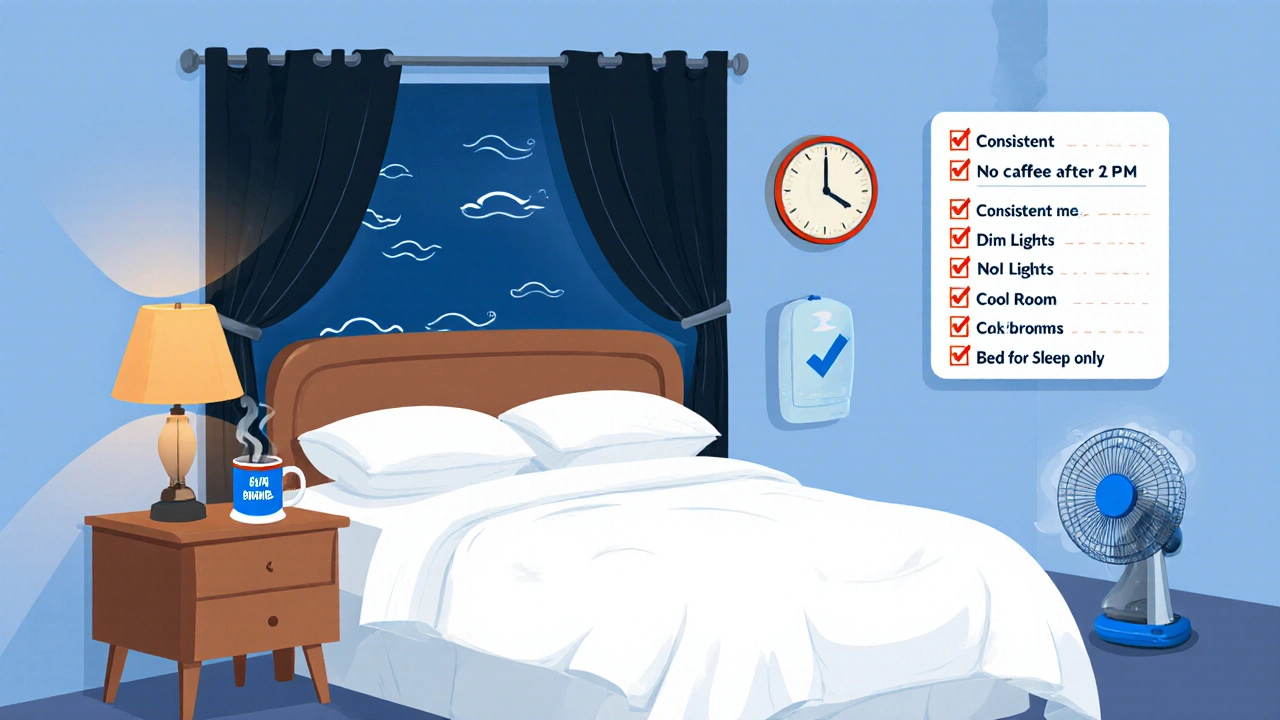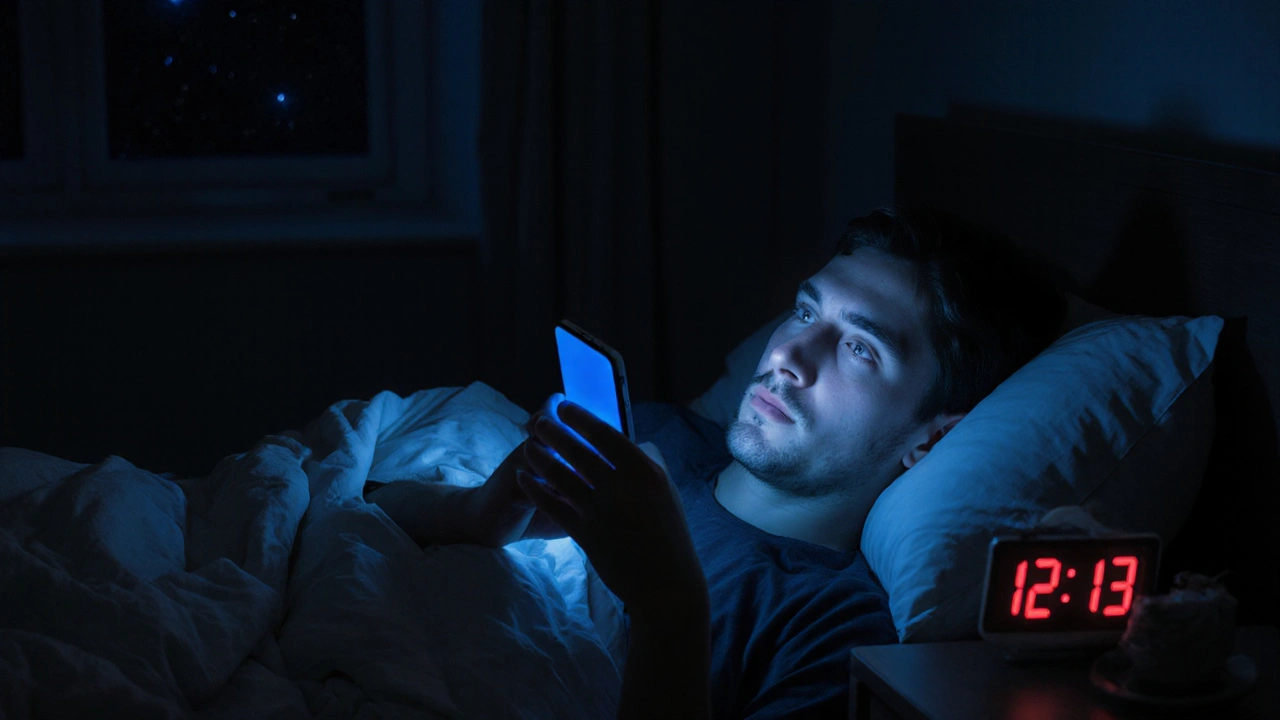Sleep Hygiene Checklist
Remember: Consistency is key to improving sleep hygiene. Small daily changes lead to big improvements over time!
When you lie awake scrolling through your phone, the clock ticking louder with each passing minute, you’re probably wondering why ‘just sleeping more’ doesn’t fix the problem. The missing piece is often not a medication but a set of everyday habits that shape how your body winds down. That collection of habits is called sleep hygiene a group of practices and environmental tweaks designed to improve the quality and duration of sleep. By cleaning up those habits, many people can turn chronic tossing‑and‑turning into a manageable routine.
Key Takeaways
- Sleep hygiene is the first line of defense against insomnia.
- Consistent bedtime, dim lighting, and a cool bedroom are the biggest impact factors.
- Stimulants like caffeine and alcohol can sabotage even the best routines.
- When hygiene tweaks fail, evidence‑based therapies such as CBT‑I become the next step.
- A simple nightly checklist helps you stay on track.
What Is Sleep Hygiene?
Sleep hygiene refers to the habits and environmental conditions that support healthy sleep patterns. In technical terms, it is the practice of aligning daily activities, light exposure, and bedroom settings with the body’s natural circadian rhythm the internal 24‑hour clock that regulates sleep‑wake cycles. When these elements are out of sync, the brain struggles to initiate and maintain deep, restorative sleep, leading to insomnia a condition characterized by difficulty falling or staying asleep.
How Sleep Hygiene Directly Affects Insomnia
Insomnia isn’t just a lack of hours; it’s a mismatch between the body’s sleep drive and external cues. Poor sleep environment factors like noise, light, temperature, and comfort level in the bedroom can keep the brain in a heightened state of alertness. Bright screens or late‑night light exposure the amount of artificial light reaching the eyes after sunset suppress melatonin, delaying sleep onset. Meanwhile, consuming caffeine a stimulant found in coffee, tea, and many soft drinks within six hours of bedtime can keep the nervous system revved up, extending the time it takes to fall asleep.
Even the temperature of the bedroom the primary sleeping space, typically a private room with a bed and minimal distractions matters. Research shows that a cool room-around 65°F (18°C)-helps lower core body temperature, a signal that the body uses to transition into sleep. If the room is too warm, that signal is muted, and you may spend more time lying awake.
Core Sleep Hygiene Practices
- Set a consistent sleep schedule. Go to bed and wake up at the same time every day, even on weekends. Consistency reinforces the circadian rhythm.
- Limit light after sunset. Dim household lights, use blue‑light‑filter glasses, or switch devices to night mode. Aim for light exposure reduction in blue‑wavelength light during the evening hours below 30 lux.
- Watch what you ingest. Avoid caffeine after 2pm and keep alcohol to one drink max and not within three hours of bedtime. Both substances can fragment sleep architecture.
- Create a cool, dark, quiet bedroom. Use blackout curtains, earplugs, or a white‑noise machine. Set the thermostat to 65-68°F (18-20°C).
- Reserve the bed for sleep. No work, scrolling, or TV in bed. This strengthens the mental association between your mattress and falling asleep.
- Incorporate gentle exercise. Regular exercise physical activity that raises heart rate and improves overall health-preferably earlier in the day-boosts sleep pressure.
- Practice relaxation techniques. Deep breathing, progressive muscle relaxation, or a brief meditation before lights‑out can calm the nervous system.

Designing Your Personal Sleep Hygiene Routine
Everyone’s schedule and preferences differ, so a one‑size‑fits‑all checklist won’t work. Follow these steps to craft a routine that feels natural:
- Write down your typical wake‑up time. Count back 7-9hours to determine the ideal bedtime.
- Identify “trigger” activities (late coffee, scrolling, heavy meals) that push bedtime later. Replace them with low‑stimulus tasks such as reading a paperback.
- Set a pre‑sleep wind‑down window of 30-45minutes. During this time, dim lights, turn off screens, and engage in a relaxation technique.
- Adjust bedroom temperature the night before. If the room tends to warm up, open a window or use a fan.
- Track your sleep for two weeks using a simple journal or a phone app. Note bedtime, wake‑time, and any disturbances.
- Review the data and fine‑tune one variable at a time (e.g., shift bedtime 15minutes earlier). Small, incremental changes are easier to sustain.
Common Pitfalls and How to Fix Them
Even with a solid plan, people stumble. Here are the usual suspects and quick fixes:
- Inconsistent weekends. If you’re tempted to sleep in, limit the drift to no more than one hour. Larger shifts can reset your circadian rhythm.
- Hidden caffeine. Remember that chocolate, certain pain relievers, and energy drinks contain caffeine. Check labels if you’re sensitive.
- Late‑night snacking. Heavy, spicy meals can cause reflux, while sugary snacks spike blood sugar and later cause wakefulness. Opt for a light snack like a banana if you’re truly hungry.
- Screen overload. Even with night mode, the blue light can linger. Try a dedicated e‑ink reader or print a paper book for bedtime reading.
- Noise surprises. If a partner snores or traffic spikes, consider a white‑noise machine or earplugs.
When Sleep Hygiene Isn’t Enough
Some people will try all the above tricks and still find themselves staring at the ceiling. That’s when evidence‑based therapies step in. CBT‑I Cognitive Behavioral Therapy for Insomnia, a structured program that changes thoughts and behaviors around sleep has a success rate above 70% in clinical trials. Unlike medication, CBT‑I teaches lasting skills: stimulus control, sleep restriction, and cognitive restructuring.
If insomnia persists for more than three months despite good hygiene, it’s wise to consult a sleep specialist. They can rule out underlying conditions such as sleep apnea, restless‑leg syndrome, or mood disorders that require targeted treatment.
Quick Sleep Hygiene Checklist
| Practice | Good Habit | Poor Habit |
|---|---|---|
| Bedtime consistency | Same time each night | Variable times, especially weekends |
| Light exposure | Dim lights, no screens 1hour before bed | Bright screens, overhead lights late night |
| Caffeine intake | None after 2pm | Late coffee or soda |
| Bedroom environment | Cool, dark, quiet | Warm, noisy, light‑filled |
| Pre‑sleep routine | Relaxing activities only | Work, intense exercise, gaming |
By checking each row daily, you’ll catch slip‑ups before they snowball into full‑blown insomnia.
Frequently Asked Questions
Can I improve insomnia without medication?
Yes. A disciplined sleep hygiene routine can reduce sleep onset latency and night‑time awakenings for many people. If symptoms persist, combining hygiene with CBT‑I or a brief medication course under doctor supervision often yields the best results.
How long does it take to notice changes?
Most people see measurable improvement within 1-2 weeks of consistent practice. The brain needs about 5-7 nights to adjust to a new bedtime pattern.
Is napping okay with insomnia?
Short naps (20‑30minutes) early in the afternoon can be refreshing and won’t usually interfere with nighttime sleep. Longer or late‑day naps can reduce sleep pressure and worsen insomnia.
Should I avoid all alcohol before bed?
Alcohol may help you fall asleep faster, but it fragments the second half of the night, reducing REM sleep. Limiting intake to one drink and finishing at least three hours before bedtime is a safer approach.
What role does exercise play?
Regular aerobic activity boosts total sleep time and deep‑sleep proportion. However, vigorous workouts within two hours of bedtime can raise core temperature and delay sleep onset, so aim for morning or early‑evening sessions.




mitch giezeman
One of the easiest ways to boost sleep quality is to treat bedtime like a non‑negotiable appointment. Start by setting a consistent lights‑out time and stick to it even on weekends, because regularity trains your internal clock. Keep the bedroom cool-around 65°F works for most people-and eliminate bright lights at least an hour before you plan to sleep. Swapping late‑night scrolling for a short chapter in a physical book helps lower melatonin‑suppressing blue light exposure. Finally, reserve the bed strictly for sleep and intimacy; doing work or watching TV there can break the mental association that tells your brain it’s time to wind down.
Kelly Gibbs
Sounds like a solid plan.
KayLee Voir
When you start building a sleep routine, think of it as training a muscle rather than flipping a switch. First, write down the exact time you need to wake up for work or school, then count back seven to nine hours to find your target bedtime. Next, create a wind‑down window of 30‑45 minutes where you dim the lights, turn off electronic devices, and engage in a low‑stimulus activity like reading a paperback or gentle stretching. During this period, avoid caffeine, nicotine, and heavy meals, because they can keep your nervous system on high alert. A cool bedroom temperature-ideally between 65 and 68 degrees Fahrenheit-helps lower your core body temperature, a natural cue for sleep onset. Consider using blackout curtains or a sleep mask to block any stray light that might trick your brain into thinking it’s still daytime. If you share a space, try white‑noise machines or earplugs to mask sudden noises that could cause micro‑awakenings. Consistency is key: even on weekends, limit any shift in bedtime to no more than one hour, otherwise you risk resetting your circadian rhythm. Track your progress for at least two weeks using a simple journal: note the time you went to bed, the time you fell asleep, any awakenings, and how you felt in the morning. Review the data and tweak one variable at a time-perhaps moving bedtime earlier by 15 minutes or cutting screen time an extra ten minutes-so you can see what truly makes a difference. Remember that it’s normal to have occasional nights where sleep is elusive; the goal is to improve the overall trend, not achieve perfection every single night. If after several weeks you still struggle with falling asleep or staying asleep, consider consulting a sleep specialist for a deeper evaluation, such as screening for sleep apnea or restless‑leg syndrome. Finally, combine good sleep hygiene with other healthy habits-regular daytime exercise, balanced nutrition, and stress‑management techniques-to create a holistic lifestyle that supports restorative sleep.
Bailey Granstrom
This checklist is just a gimmick.
Melissa Corley
lol u think a list of boxes will fix all ur sleeepy probs 😂😂 u gotta rly change life not just tick stuff!!
Kayla Rayburn
I get where you’re coming from-sometimes it feels like a quick fix. Still, a simple checklist can serve as a reminder, especially when you’re busy. Adding one habit at a time often works better than overhauling everything all at once.
Dina Mohamed
Wow!!! This is exactly what I needed!!! Keep the tips coming!!! The more detail the better, especially the part about the cool bedroom-never thought about that!!!
Kitty Lorentz
thanks for the advice i will try the cool room and no screens before bed it should help me feel more rested
inas raman
Hey folks! Let’s remember that sleep isn’t just a solo mission-family habits matter too. If your partner’s snoring or late‑night habits disrupt you, have a friendly chat and maybe set a shared “quiet hour” rule. Small changes together create a supportive environment for everyone.
Jenny Newell
While the practical steps are solid, the post could benefit from integrating more terminology around sleep architecture, such as REM latency and slow‑wave sleep, to appeal to a more technical audience.